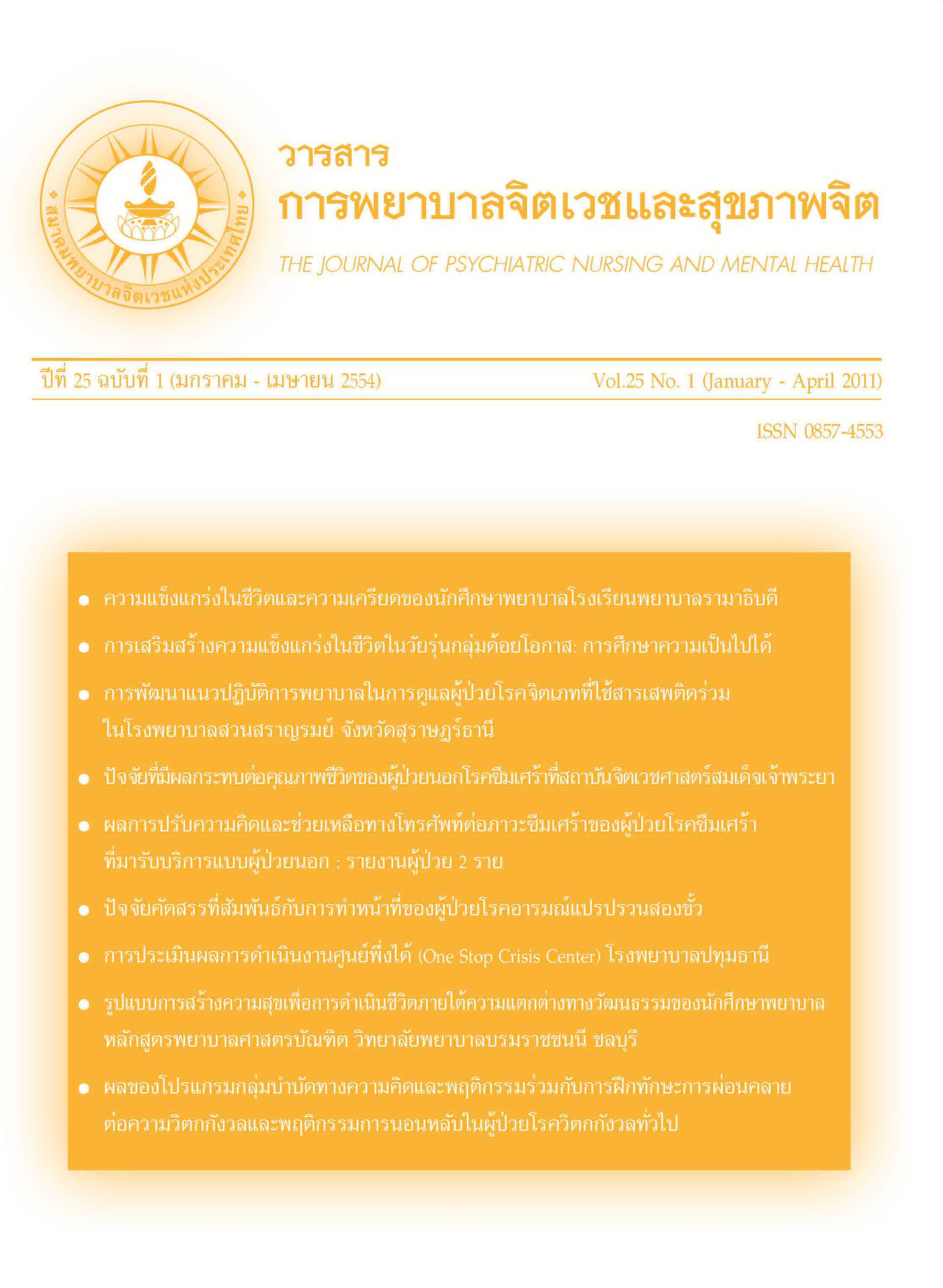การเสริมสร้างความแข็งแกร่งในชีวิตในวัยรุ่นกลุ่มด้อยโอกาส: การศึกษาความเป็นไปได้
Main Article Content
บทคัดย่อ
บทคัดย่อ
การศึกษานี้มีวัตถุประสงค์เพื่อ ศึกษาความ เป็นไปได้ของการนำโปรแกรมการเสริมสร้าง ความแข็งแกร่งในชีวิตมาใช้ในวัยรุ่นกลุ่มด้อยโอกาส โปรแกรมที่ใช้ในการศึกษาครั้งนี้ดัดแปลง มาจากโปรแกรมการเสริมสร้างความแข็งแกร่ง ในชีวิตซึ่งพัฒนาโดย ประเวช ตันติพิวัฒนสกุล (2551; 2552) โดยเลือกใช้กิจกรรมที่จะใช้ในการ เสริมสร้างความแข็งแกร่งในชีวิตตามแนวคิด ของกรอทเบิร์ก (Grotberg, 1995; 2001) ซึ่งมี 3 องค์ประกอบ (‘I have’ ‘I am’ และ ‘I can’) รวมทั้งสิ้น 8 กิจกรรม ดังนี้ 1) I have: เป็น แหล่งสนับสนุนภายนอกที่ส่งเสริมให้เกิดความ แข็งแกร่งในชีวิต 2 กิจกรรม 2) I am: เป็นความ เข้มแข็งภายในของแต่ละบุคคล 3 กิจกรรมและ 3) I can: เป็นปัจจัยด้านทักษะในการจัดการกับ ปัญหาและสัมพันธภาพระหว่างบุคคล 3 กิจกรรม กลุ่มตัวอย่างที่ใช้ในการศึกษาครั้งนี้เป็นนักเรียน ชั้นมัธยมศึกษาปีที่ 3 โรงเรียนศึกษาสงเคราะห์ แห่งหนึ่งจำนวน 28 คน
ผลการศึกษาพบว่า ภายหลังเข้าร่วมโปรแกรม วัยรุ่นกลุ่มด้อยโอกาสมีค่าคะแนนเฉลี่ยของความ แข็งแกร่งในชีวิตสูงกว่าก่อนเข้าร่วมโปรแกรม อย่างมีนัยสำคัญทางสถิติ (p = .004) และพบว่า เนื้อหาโปรแกรมและกิจกรรมที่ใช้ดำเนินโปรแกรม มีความเหมาะสม นักเรียนมีความสนใจและพึง พอใจในการเข้าร่วมโปรแกรม และยังพบว่าทั้ง นักเรียนและครูมีความคิดเห็นว่าโปรแกรมนี้มี ประโยชน์ต่อการนำไปใช้ในชีวิตประจำวัน จาก ผลการศึกษาครั้งนี้ แสดงให้เห็นว่าโปรแกรมการ เสริมสร้างความแข็งแกร่งในชีวิตนี้มีความเป็น ไปได้ ในการนำไปประยุกต์ใช้เพื่อเสริมสร้าง ความแข็งแกร่งในชีวิตสำหรับวัยรุ่นด้อยโอกาส หรือนักเรียนในโรงเรียนอื่นๆ ให้มีประสิทธิภาพ ยิ่งขึ้น
คำสำคัญ : วัยรุ่นด้อยโอกาส, การเสริมสร้างความแข็งแกร่งในชีวิต
Abstract
The present study aimed at investigating the feasibility of a program to promote resilience in underprivileged adolescents. The modified resilience promotion program developed by Prawat Tantipiwattanasakul (B.E. 2551, 2552) was employed in the present study, which selected activities to promote resilience based on the concept of Grotberg (1995, 2001) that consisted of three components: ‘I have,’ ‘I am,’ and ‘I can.’ Altogether there were eight activities in this study: 1) two activities of ‘I have’ which were outside sources of support that promoted resilience, 2) three activities of ‘I am’ which were the internal strength of the individuals, and 3) three activities of ‘I can’ which refered to the problem-solving skills and interpersonal skills. The subjects in this study were 28 students from Mattayom 3 (Grade 9) at one suksasongkroa school.
The results revealed that after participating in the program, the mean score of resilience of underprivileged adolescents increased with statistical significance (p = .004). It was also found that the program’s content and the activities involved in the program’s implementation were appropriate for the students who were interested in and satisfied with their participation in the program. In addition, the findings showed that both students and teachers felt that the program was beneficial for their daily life. Thus, it could be concluded that the resilience promotion program could be implemented to effectively promote resilience among underprivileged adolescents as well as other groups of students in the school.
Keywords : Under Privileged Adolescents, Promoting Resilience
Article Details
บทความที่ได้รับการตีพิมพ์แล้ว เป็นลิขสิทธิ์ของสมาคมพยาบาลจิตเวชแห่งประเทศไทย


